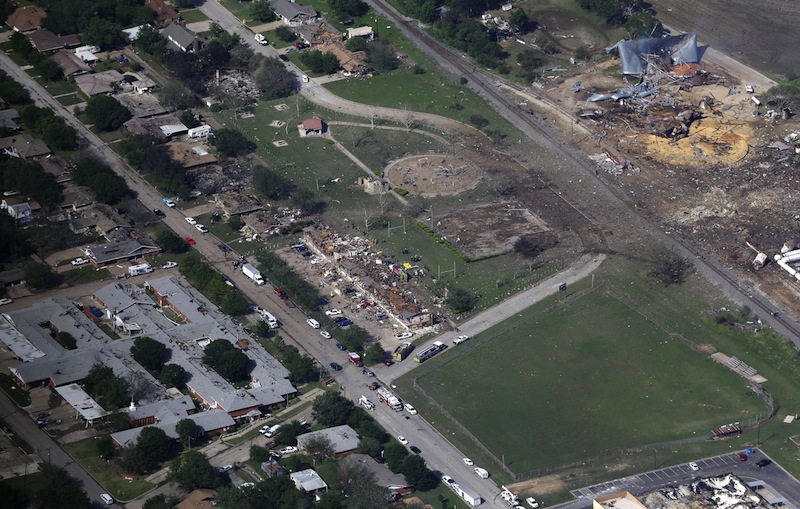WEST, Texas (AP) — The bodies of 12 people have been recovered from the remnants of a tiny Texas farm town that was rocked by a roaring explosion at a fertilizer plant, authorities said Friday, confirming for the first time the number of people who perished in the accident.
Officials did not identify those killed, but the dead were believed to include a small group of firefighters and other first-responders who rushed toward the West Fertilizer Co. to battle a fire that apparently touched off the blast.
Texas Department of Public Safety Sgt. Jason Reyes said he could not confirm how many first-responders had been killed. Efforts to search the devastated buildings were continuing, he added.
The Wednesday evening explosion was strong enough to register as a small earthquake and could be heard for many miles across the Texas prairie. It demolished nearly everything for several blocks around the plant. More than 200 people were hurt.
Even before investigators disclosed the fatalities, the names of the dead were becoming known throughout the community of 2,800. Townspeople gathered late Thursday for a service at St. Mary of the Assumption Catholic Church.
“We don’t know what to think,” the Rev. Ed Karasek told those gathered at the service. “Our town of West will never be the same, but we will persevere.”
Christina Rodarte, who has lived in West for 27 years, said “everyone knows the first-responders, because anytime there’s anything going on, the fire department is right there, all volunteer.”
The only fatality who has been publicly identified was Kenny Harris, a 52-year-old captain in the Dallas Fire Department who lived south of West. He was off-duty at the time but responded to the fire to help, according to a statement from the city of Dallas.
Brenda Covey once lived in the now-leveled apartment complex across the street from the plant.
On Thursday, she learned that two men she knew were dead, both of them volunteer firefighters. One had been the best man at her nephew’s wedding.
“Word gets around quick in a small town,” said Covey, who has lived all her life in and around West.
Firefighter Darryl Hall, from Thorndale, about 50 miles away from West, was one of the rescue workers helping with the house-to-house search.
“People’s lives are devastated here. It’s hard to imagine,” Hall said.
Federal investigators and the state fire marshal’s office planned to begin inspecting the blast site Friday to collect evidence that may point to a cause.
Franceska Perot, a spokeswoman for the Bureau of Alcohol, Tobacco, Firearms and Explosives, said investigators would begin at the perimeter of the explosion and work inward toward the destroyed fertilizer company.
As investigators move inward, residents will gradually be allowed to return to their homes, authorities said.
It was clear was that the town’s landscape would never be the same. An apartment complex was badly shattered, a school set ablaze and a nursing home left in ruins.
Garage doors were ripped off homes. Fans hung askew from twisted porches. At West Intermediate School, which was close to the blast site, all of the building’s windows were blown out, as well as the cafeteria.
The fertilizer facility stores and distributes anhydrous ammonia, a fertilizer that can be directly injected into soil. It also mixes other fertilizers.
Records reviewed by The Associated Press show the U.S. Pipeline and Hazardous Materials Safety Administration fined West Fertilizer $10,000 last summer for safety violations that included planning to transport anhydrous ammonia without a security plan. An inspector also found the plant’s ammonia tanks weren’t properly labeled.
The government accepted $5,250 after the company took what it described as corrective actions, the records show. It is not unusual for companies to negotiate lower fines with regulators.
In a risk-management plan filed with the Environmental Protection Agency about a year earlier, the company said it was not handling flammable materials and did not have sprinklers, water-deluge systems, blast walls, fire walls or other safety mechanisms in place at the plant.
State officials require all facilities that handle anhydrous ammonia to have sprinklers and other safety measures because it is a flammable substance, according to Mike Wilson, head of air permitting for the Texas Commission on Environmental Quality.
But inspectors would not necessarily check for such mechanisms, and it’s not known whether they did when the West plant was last inspected in 2006, said Ramiro Garcia, head of enforcement and compliance.
That inspection followed a complaint about a strong ammonia smell, which the company resolved by obtaining a new permit, said the commission’s executive director Zak Covar. He said no other complaints had been filed with the state since then, so there haven’t been additional inspections.
___
Associated Press writers Will Weissert, Michael Brick, Nomaan Merchant and Angela K. Brown and video journalists John L. Mone and Raquel Maria Dillon in West; writers Jamie Stengle in Dallas, Ramit Plushnick-Masti in Houston and Seth Borenstein and Jack Gillum in Washington contributed to this report.










